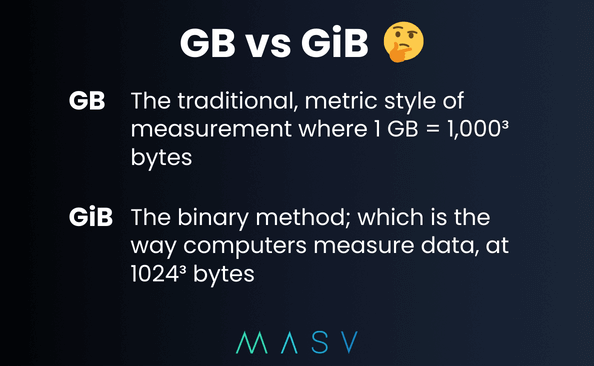GB vs GiB—why the lowercase ‘i’?
At first what may seem like a typo is actually a separate unit of measurement with a long, complicated history. Both GB and GiB display storage capacity on a computer but one will display less available memory than the other.
Let’s say you just picked up a one TB hard drive. You’d probably expect it to have 1,000 gigabytes (GBs) of storage, since tera is a unit of measurement in the metric system. But it won’t. Instead, it’ll have around 931 GBs of storage.
This is confusing for most people—so much so that it has even been the focus of class-action lawsuits against hard drive makers in the past. The suits ended in settlements, but weren’t admissions of misconduct by the companies, for reasons we’ll get into below.
Indeed, all this uncertainty isn’t due to some malevolence on the part of hardware makers. Rather, it’s the result of a chain of seemingly innocuous decisions made several decades ago by those in the technology industry, leading to two very similar but also very different measurements: GB vs GiB—or gigabytes vs gibibytes.
Table of Contents
Need to Transfer Large Files?
Create a free MASV account to get started.
GB vs GiB: So What is the Difference?
At its most basic level, one GB is defined as 1000³ (1,000,000,000) bytes and one GiB as 1024³ (1,073,741,824) bytes. That means one GB equals 0.93 GiB.
Seems straightforward, right? It’s not.
Thirty years ago GiBs as a measurement didn’t even exist. GBs, at that time, represented both units of measurement depending on the context. This confusion has persisted to the present day.
This strange state of ambiguity is rooted in the fact that while computer data is generally measured in binary code, the prefixes used to measure that data (kilo, mega, tera, peta, etc.) derive from the metric system. A metric “kilo” equals 1,000, but a binary “kilo” equals 1,024.
Several decades ago, when the high-end of memory capacity was measured in kilobytes (kB), this difference seemed negligible. As the International Electrotechnical Commission (IEC) explains:
“As a matter of convenience, (engineers) began referring to 1,024 bytes as a kilobyte. It was, after all, only a 2.4% difference, and all the professionals generally knew what they were talking about among themselves.”
Now, however, we have access to terabytes of data storage and work with files many times larger than those in the 1980s could even imagine. The higher the amount of storage, the more the gulf widens: there’s a 7% size difference between GBs and GiBs, for example, compared to the aforementioned 2.4% difference between kB and KiB. And as file sizes increase further, so does this disparity.
But let’s hang on a minute. If GiBs didn’t even exist a few decades ago, where the heck did they come from?
How Did GiBs Come to Be?
In order to alleviate confusion and draw a line in the sand once and for all, the aforementioned IEC developed a new international standard of measurement using non-metric prefixes for the binary measurements. Under this new standard a kB held its metric value (1,000 bytes) while a brand-new unit of measure, the kibibyte, represented the binary version (1,024 bytes).
Kibibytes (KiB) were joined by their counterparts, mebibyte (the binary version of megabyte), gibibyte, tebibyte, pebibyte, and so on down the line.
Here’s a comparison of how some of the measurements set out in 1998 compare to their metric counterparts:
| Unit of Measure | Bytes |
| Kilobyte (kB) | 1,000¹ = 1,000 |
| Megabyte (MB) | 1,000² = 1,000,000 |
| Gigabyte (GB) | 1,000³ = 1,000,000,000 |
| Terabyte (TB) | 1,000⁴ = 1,000,000,000,000 |
| Petabyte (PB) | 1,000⁵ = 1,000,000,000,000,000 |
| Unit of Measure | Bytes |
| Kibibyte (KiB) | 1,024¹ = 1,024 |
| Mebibyte (MiB) | 1,024² = 1,048,576 |
| Gibibyte (GiB) | 1,024³ = 1,073,741,824 |
| Tebibyte (TiB) | 1,024⁴ = 1,099,511,627,776 |
| Pebibyte (PiB) | 1,024⁵ = 1,125,899,906,842,620 |
GB vs GiB: Measurement Conversions
Here’s how to convert a metric unit of measurement into a binary one (and vice versa):
GB to GiB, GiB to GB
As mentioned a GB is 0.93 of a GiB (0.931323, to be exact). Simply multiply by this value to go from GB to GiB, or divide by this value to go from GiB to GB.
TB to TiB, TiB to TB
A TB is 0.909495 of a TiB. Multiply by this value to go from TB to TiB, or divide by this value to go from TiB to TB.
GiB to TiB, TiB to GiB
Divide by 1,024 to convert a number from GiB to TiB; multiply by 1,024 to convert from TiB to GiB.
Put another way:
| Unit | Is Equal To… |
| 1 GB | 0.93 GiB |
| 1 TB | 0.91 TiB |
| 1 TiB | 1024 GiB |
| 1 TiB | 1.1 TB |
And there you have it. International standards to the rescue. Issue solved and crisis averted, right?
Well, not quite.
Need to Transfer Large Files?
Create a free MASV account to get started.
GB vs GiB: The Confusion Persists

Photo by Tim Gouw on Unsplash
Unfortunately, while these IEC measurements are useful and have existed for more than two decades, many (most?) people still haven’t heard of them or have any clue what they are. Many technology veterans often still go on the assumption that one GB equals 1,024 MB until told otherwise.
Exacerbating the issue is the utter lack of standards with teeth governing various companies when presenting these measurements: There are no hard and fast rules on what measurement a company can or should use. Most hardware manufacturers (such as hard drive makers), for example, typically list storage capabilities in GB. Windows operating systems report in GiB but present these numbers as GB—hence all that hard drive capacity uncertainty (and lawsuits) we mentioned up top.
The difference can also lead to discrepancies when viewing the same file on different operating systems. Unlike Windows machines, Mac OS shows memory capacity using the digital version of GB (and has since the Snow Leopard release in 2009).
This is especially important if you’re sharing files. A user who receives a file from a Mac to their Windows machine will see a drop in file weight, which can raise concerns about the integrity of the file transfer. The user might think the file was corrupted during transit or some sort of compression was applied which is a hard no when sharing high-resolution files (e.g RAW video files).
In reality, there is no corruption or compression, and there’s nothing wrong with the file transfer tool.
Why GB vs GiB Matters When Working With Large Files
There are plenty of reasons why professionals who send and receive massive files should know the difference between GB and GiB. For one thing, file size can impact transfer time.
“For example, the difference between the transfer time of a one gigabyte (1,000 megabytes) file is going to be significantly better than a true binary gigabyte (referred to as a gibibyte) that contains 1,024 megabytes,” explains the IEC. “The larger the file used for data transfer, the bigger the difference.”
💡 Calculate how long it will take to deliver a large file with our File Transfer Calculator.
The discrepancy can also affect cost: Because one GB equals 0.93 GiB, a file transfer service charging clients in GB would end up billing significantly more over the long run than one using GiB.
At MASV, our large file transfer service displays file sizes using the digital version (GB)—mostly because it’s a more familiar measurement for our users. But, we always charge by GiB. So, if you send a 100 GB file, you’ll actually be charged for 93 GiB worth of data. That means MASV users always pay the lowest possible file transfer fees, even when sending extremely large files.
Conclusion
To recap the debate between GB vs GiB: both prefixes are units of measurement on digital devices.
- GB is the traditional, metric style of measurement with 1 GB equaling 1,000³ bytes.
- GiB is the binary method; which is the way computers measure data at 1024³ bytes.
Most hardware manufacturers, like a HDD or SSD provider, will list products in the metric format as it is more familiar to the general consumer. This means, although you’re purchasing a one TB drive, you will actually have less data available once the drive is connected to your computer.
This is an important distinction when evaluating external storage and file transfer solutions. If you’re dealing with large files, where every byte is of critical importance, you need to make sure you’re getting your money’s worth of data transfer.

MASV is the fast, easy, and affordable way to deliver truly massive files. Our customers use us to share large files from 200 GBs to 15 TBs faster than the competition.
Our usage-based model means you only pay for the data you use. And although we display our pricing in the metric style of measurement, we bill at binary which means you’re being charged for less data than you’re spending.
Sign-up for MASV and receive 10 GB free monthly, then Pay As You Go for additional usage after 10 GB. Signing-up also unlocks full access to our MASV Portal, Integration, and Automation features.
Need to Send Large Files?
Create a free MASV account to get started.
